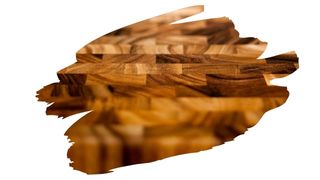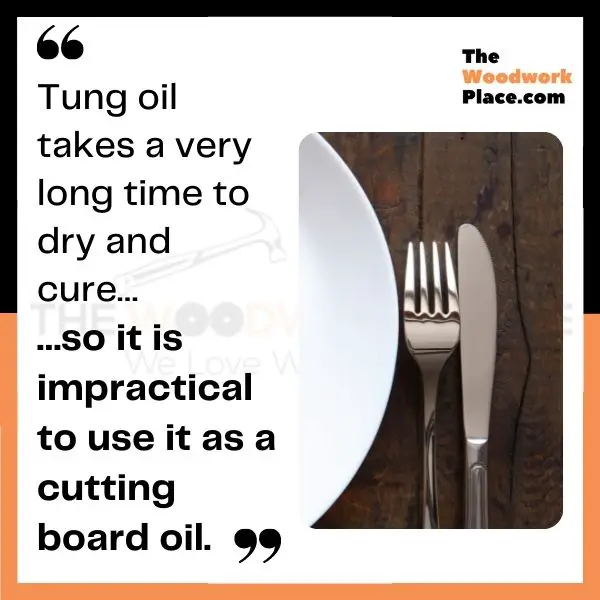It can take Tung oil up to four weeks to fully cure and harden. Which is about how long you should wait, before using any wooden utensil coated in this oil finish.
That is because, only after Tung oil has finished drying and curing, is it deemed a food safe finish.
Yet, knowing all of this, is Tung oil really food safe enough to seal a cutting board? In theory, yes…but in practice? Probably not.
So in this post, you will learn why that slow-curing Tung oil finish isn’t the most practical way to maintain a cutting board. You will also discover why many so-called Tung oil finishes are anything but the real thing.
And we reveal what kind of oil you should really be using to safely seal and protect your homemade cutting board.

This post may contain affiliate links to products that we receive a commission for (at no additional cost to you). Learn more here.
Is Tung Oil Safe For Food Prep Surfaces?
Once it has dried and cured, then yes, it is safe.
Tung oil finishes are classed as a drying oil. That is because, once this oil is exposed to air, through polymerization it naturally cures and hardens.
And after that pure Tung oil finish hardens, it forms a food safe resin.
Related Post: What Will Fractionated Coconut Oil Do To Your Cutting Board?
But Why Is Curing So Important (When It Comes To Food Safety)?
Well, Tung oil is a pure natural oil extracted from the seeds of the Tung oil Tree (aka Vernicia fordii).
According to the University of Florida Institute of Food And Agricultural Sciences, all parts of this tree are poisonous. Which would include the pure unfiltered oil extracted from this trees seeds.
But, once Tung oil has cured (which can take a while), it is food safe. However, a food safe finish does not equal a food grade finish.
And when it comes to certain food prepping surfaces, such as cutting boards, food grade is the safest way to go.
What Is The Difference Between A Food Safe And Food Grade Oil Finish?
The difference mostly lies in whether or not that oil is safe to consume.
Raw Linseed oil is both a food grade and food safe finish. As an oil it can be safely consumed. And after it has cured, it forms a food safe seal too.
Tung oil, on the other hand, is a food safe finish only. In pure unfiltered oil form, it is not safe to consume. However, after it has cured, it is food safe…even safe enough to eat off.
But the way we use our cutting boards, means that Tung oil isn’t a suitable sealant for these items.
How Long Before Tung Oil Is Food Safe? Tung oil can take up to 30 days to wholly cure. But, it can take longer to cure in colder or more humid climates.
Does That Mean Tung Oil Is Not OK To Use On Cutting Boards?
There are a couple of good reasons to skip over Tung oil for your cutting board:
1). It Takes Ages To Cure
After you seal your board with Tung oil, you must wait for the finish to wholly cure before you use that board. That means your cutting board will be out of commission for weeks.
However, the secret to Tung oils time-honored water-resistance, lies in its ‘build-up’. Repeated reapplication of this natural oil finish is where the magic happens.
The increasing Tung oil coats added to wood (over time) makes wood ever more water-resistant. Especially as it overlays the previous Tung oil coat. So applying a Tung oil finish is not a once-and-done deal.
Which is why Tung oil needs to be reapplied every 6-12 months. Especially when that wooden surface is regularly drenched with water.
And the waiting-around-for-it-to-cure timer will start all over again, after you reapply it.
2). It Is Not A Food Grade Finish
The way we use cutting boards involves chopping, slicing and dicing. Which means that little bits of Tung oil resin could get into your food.
Its fine to place food upon a cured solid Tung oil finish. However, you do not want this finish getting into your actual food, all the same.
This is why Tung oil isn’t suitable for a cutting board. If you want to seal cutting boards, you should be using a food grade wood finish.
Related Post: Walnut Oil Vs Mineral Oil: Which One’s Better For Your Cutting Board?
So, What Is The Best Kind Of Oil You Can Use On A Cutting Board?
You should use mineral oil. Or, to be more exact, use 100% pure food grade mineral oil.
Mineral oil is a highly filtered and 100% food grade wood finish.
It is non-drying, so no need to wait around for it to cure. And it is incredibly quick to apply. In fact, you can start to use your cutting board within 24 hours of application.
And while this non-drying oil finish is made from petroleum distillate, it is a very refined petroleum, so it’s non-toxic. Neither will it go rancid.
Related Post: Don’t Put Tung Oil Over Mineral Oil (Here’s What You Should Do Instead)
But, as a non-drying oil, it is not as durable as a drying oil, such as Tung oil. So, mineral oil will need to be frequently reapplied (every 1-2 weeks, depending on how often you use that board).
Best of all, you can get this stuff from any local store or pharmacy. Or you can buy Bayes High-Performance Food Grade Mineral Oil online.
Bayes mineral oil is 100% pure, and it will soak right into that chopping block in minutes.
You can find the latest prices for Bayes mineral oil (made in the USA) over on Amazon.

Is Tung Oil The Same Thing As Mineral Oil?
No, these two oils are very different from one another.
Tung oil is a drying oil that will leave behind a dry hard film. Mineral oil is a non-drying oil that will leave behind a permanent ‘greasy’ feel.
Tung oil comes from the Tung tree. Mineral oil comes from petroleum. Tung oil is food-safe (but non-consumable). Mineral oil is food-grade (consumable). And the list goes on…
The only point that these two oils do share is that they are both great wood preservatives. Both of them will soak into wood grain, making wood much less water absorbent.
Related Post: Walrus Oil Vs Odie’s Oil: Which One’s Better For Your Cutting Board?
What If You Want To Seal A Cutting Board With Tung Oil Anyway?
If you have your heart set on using Tung oil on your chopping block, then make sure you use a pure Tung oil product.
Pure Tung oil is made 100% from Tung oil. However, a surprising number of Tung oil marketed products, are anything but.
These are essentially faux-Tung oils that blend a little bit of Tung oil with polyurethane or varnish. They sometimes even include thinners and other chemicals.
Basically, faux-Tung oils are more of a Teak oil styled product, than anything. In some cases, they don’t even have any Tung oil in them whatsoever.
These faux-Tung oils should not be used on your cutting board, for the simple fact that they are made from a hodgepodge of ingredients.
So, if you use Tung oil on a cutting board, always use a 100% pure Tung oil product, such as Liberons Pure Tung Oil.
Liberons market-leading premium oil finish can be used to seal wooden utensils, kitchen countertops and cutting boards. And this is all thanks to the fact that it does not include any dryer additives in it.
You can find the latest prices for this premium pure Tung oil finish over on Amazon.
To Wrap Up, Here Are The 3 Main Takeaways…
- 1). After Tung oil has cured, it is a food safe finish. Which means you can use it to seal food prep surfaces.
- 2). However, Tung oil takes a very long time to dry and cure. Plus, it is not a food grade finish. So, it is not suitable for use on cutting boards and chopping blocks.
- 3). Instead, use 100% pure food-grade mineral oil to seal and condition your cutting board.
References:
Vernicia fordii (Tung oil tree) | University of Florida Institute of Food And Agricultural Sciences
Correction: In the original post we mistakenly said that natural pure Tung oil needed an additional treatment in order to cure and harden. We have updated the post and fixed our mistake on 16th November. Apologies for the oversight!



